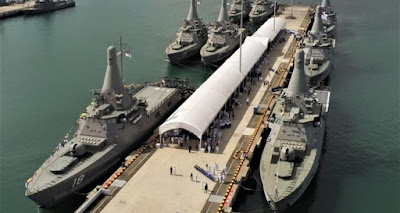Ready, Aye Ready: All eight Republic of Singapore Navy Littoral Mission Vessels gather for a family photo on 31 January 2020 at Tuas Naval Base in Singapore. Spot the differences?
All eight Republic of Singapore Navy (RSN) Independence-class Littoral Mission Vessels (LMVs) graced the commissioning ceremony for the last three hulls - RSS Fortitude, RSS Dauntless and RSS Fearless.
Sharp eyed observers might have noticed subtle differences (visible in the top picture) between the ships. Cognoscenti and warship otakus might have understood that the differences go beyond deck markings for the Independence-class LMVs.
Still lost? The images below might help.
Upper deck modifications split the LMVs into two distinct types. Four can operate S-70 Seahawks while the rest serve as landing pads for naval Unmanned Aerial Vehicles (UAVs). Even with deck markings on LMVs dedicated for UAVs, a Seahawk can land on deck though it will be a much tigher fit.
So looking beyond deck markings, the significance of dedicating half the LMVs for UAVs points to a sea change in the concept of operations (CONOPS) for the RSN. Unlike the Victory-class Missile Corvettes (MCVs) that were retrofitted to fly ScanEagle UAVs, the LMV flight deck allows this class of ship to operate larger, more capable UAVs. This includes those that can take-off and land vertically. The elderly 62m MCVs, which are the RSN's oldest surface combatants, launch their ScanEagles via a pneumatic ramp and recover the asset via a sky hook system but do not have the space for VTOL UAVs.
This begs the question: Why not simply operate UAVs from LMVs with painted helideck markings? You could indeed but the wide-decked LMVs come with operational considerations which we won't talk about.
The distinctions are not in the same order as the characteristics that differentiate broad-beam Leanders from the early Leanders but they underline the RSN's focus on UAVs as core assets for maritime operations. The analysis needs to go beyond the rudimentary conclusion that one has a painted deck while the other was left naked. It's more than that...
In time to come, UAVs are likely to evolve beyond sensor platforms. Operational experience gained from sea time with UAVs such as the Singapore-developed V15 series will lay the foundation for the MCV replacements as well as larger assets like the Joint Multi Mission Ship.
It is heartening to note that the LMV project team has had the foresight and creativity to adapt the hull form for naval helos and VTOL UAVs.
Now that all eight have been commissioned, the hard work lies with writing and refining CONOPS for maritime UAVs, thus laying the foundation for future RSN combatants that can operate manned and unmanned naval aviation on and from the sea.


No comments:
Post a Comment